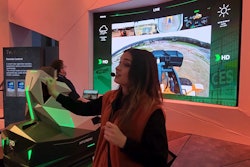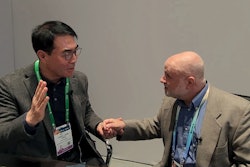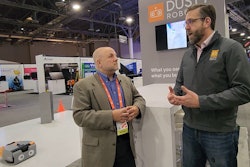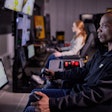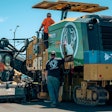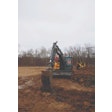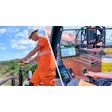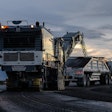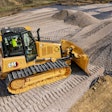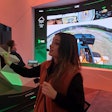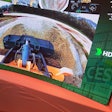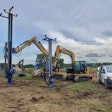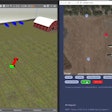
Construction machine control has become more ubiquitous, and early cases of autonomous compactors and hauling are making their way to busy job sites after use in remote and mining sites.
This may be a boon to contractors struggling to find operating engineers who can automate some work and rely on teleoperation of equipment to maximize operating engineer time as they manage multiple machines or instantly switch between machines at remote locations. But more specialized equipment may not be addressed by commercial-off-the-shelf automation or machine control solutions.
This is one problem addressed by startup Polymath Robotics, which focuses on custom automation solutions but has a new configurable product offering for bulldozers. Bulldozers have seen some automation efforts, but Polymath’s offering combines teleoperation with automation in unique ways.
“We have a bulldozer product that's being sold through HARD-LINE (now owned by Hexagon),” Polymath Robotics Founder and CEO Stefan Seltz-Axmacher said in a December 2023 call with IRONROS. “They're selling semi-autonomous bulldozers that are also teleoperated when they're not autonomous. What we do is we make it really easy for anyone to add autonomy to off-highway equipment. We're on skid steers, specialty tractors, articulated dump trucks, bulldozers, yard trucks and a big variety of different types of pieces of equipment. All of these we're able to make safer and create significant savings and ROI for our end customers.”
At the time of the call Polymath employed 10, and has received investment resources from Y Combinator, and in June of 2023 from Samsara, along with an arrangement that enables Polymath customers to teleoperate over Samsara’s platform. Sales are still handled directly by Seltz-Axmacher, but his efforts are extended by multiple other parties who can pull contractors and fleets into Polymath’s orbit.
“Who we sell to varies quite a bit,” Seltz-Axmacher said. “We're working with some OEMs where we're being built into their autonomy offering. We're working with some large operators of heavy equipment, where they're automating some part of their operations and we're fitting into their broader strategy. And then we're working with some other tech companies where they're building their own offering around our stack. So while we have folks like HARD-LINE who are selling this particular bulldozer solution, they also are selling other solutions that that have this built in. For specialty equipment, we can work with large companies that have some weird special equipment that no one else in the world uses that they just can't hire people to operate. And we can take a look at automating those as well as we can.”
Contractors engaging with Polymath Robotics, according to Seltz-Axmacher, get a straightforward ROI guarantee as the company embarks on adding automation to their equipment operations—essentially guaranteeing the contractor will save money versus their labor costs.
“In a pretty straightforward way, we and HARD-LINE might do the retrofit add teleoperation to a product,” Seltz-Axmacher said. “And then on top of that, we'll add autonomy so that you might only need one teleoperator per five to 10 bulldozers. Not only are you saving idle time, not only are you saving with fuel efficiency, but you're also just straight up saving labor dollars. Whether HARD-LINE spearheads the deal, and they do a bunch of the on-site support, or whether we work more closely with the with the contractor or with the with the equipment operator … it can kind of go either way. And we we've done both successfully so far.”
After on-boarding with the solution, either Polymath or HARD-LINE will provide service and support.
In situations where Polymath is working with other technologies with which it has integrated in the past, Seltz-Axmacher said the solution is live in about 10 days after the vehicle has been retrofit.
“If it's a brand new integration, you might be looking more like eight to 12 weeks,” Seltz-Axmacher said. “We have an engineering team that mostly focuses on continuing to improve the product and doing that sort of integration work. And then we help project manage it and make sure it's adding real customer value.”
The focus on guaranteed outcomes should be more of interest to contractors looking to automate than the size of the team delivering the technology, according to Axmacher.
“In this space, there are Fortune 500 companies who are delivering bad products to end customers,” Seltz-Axmacher said. “And whether you have one account manager or six, whether we promise there's one forward-deployed engineer or there's 10, the reality is there are companies with a lot of credibility who are promising those things and have really unhappy customers. At the end of the day, it's a relatively simple and straightforward promise that we will cost less per hour when we drive equipment than a human in that vehicle while it was moving. We're happy to put our butts on the line with that that straightforward promise.”
While some construction technology solutions may come with a standard onboarding package including a specific number of professional hours, the edge cases Polymath deals with defy that type of rigid approach.
“I think the challenge is that these vehicles are all so different, and how they how to get them up and running is also different,” Seltz Axmacher said. “Specifics like that are too specific and not general enough. For a dozer retrofit, that's a pretty straightforward thing. If they want some weird, special piece of equipment that they had welded together by a friend of the company shop, all those specifics, go out the window.”
While building the customer base is a priority, Seltz-Axmacher stressed that the company’s priority still hangs more on delivering performant solutions than new nameplates.
“Every robot needs to work—every robot needs to make sense,” Seltz-Axmacher said. “We need to get more programs started faster. And then we need to support our stakeholders in those programs to make them grow as quickly as possible. Because for us, it's not about this bulldozer in this mine. It's not about this water truck in that quarry. It's not about this yard truck in this port. It's about how do we make that bulldozer the most reliable, safest operator in that mine so we can show up three months later and say, ‘Hey, you have more bulldozers? How about we automate those? Hey, it looks like you also have water trucks. How about we automate those? Hey, it looks like you've excavators, you know, how much money how much time you can save if they can drive to the maintenance shop on their own?’ We need those customers to have the confidence to say, ‘yes, I want this, and I want more of them’ so that our customers grow month over month.”
Polymath Robotics Tech Stack
The Polymath solution is currently deployed on skid steers, tractors, bulldozers, articulated dump trucks, UTVs, yard trucks and other deployments that are proprietary and cannot be disclosed. The currently served and addressable market encompass a number of equipment categories that may be underserved by other automation offerings.
“Industries like quarries and forestry are generally underserved,” Seltz-Axmacher said. “There's a lot of noise in ag equipment, but the way people use ag equipment is so specialized and differentiated that no one can really get robots that solve the big problems for them. In places like mines and quarries and oil facilities, there is so much specialty equipment that no one in the world can really automate it.”
Barriers to automation stem not only in the fact that certain use cases may not be large enough to support development of a standard automation product.
“In general, the challenge is not around modality,” Seltz Axmacher said. “The challenge is around being OEM agnostic and the challenges around automating the particular pieces of equipment that add value to a particular site.”
The underlying equipment is one layer in the Polymath solution, with other layers complementing it in an OEM-agnostic fashion.
“When you think of automating these systems, I tend to think about five fundamental layers,” Seltz-Axmacher said. “So there's the underlying vehicle. There's the hardware integration that turns it into a robot. There's the actual software that runs on board the vehicle—the autonomy layer. There's the business logic that tells it what to do. And then there's the end user operator layer … Almost everybody is doing three or four of these layers. And the problem with doing three to four of these layers you get super narrow about where you can operate, which is why some of the big companies in this space have 600 SKUs of equipment, and can only automate three of them. What we're doing is we're just building a generalized autonomy layer that can sit on top of a whole bunch of different vehicles.”
This automation layer creates a degree of freedom in terms of the exact technologies used to support the use case.
“There are more rugged Lidars now, and Lidar should be able to survive a quarry mining type of site,” Seltz-Axmacher said. “And we've had success with that. But there's a lot of people in mining and quarries, for example, who have had a bad experience with Lidars over the last 10 years, don't want Lidar ever again, and might demand that we work off of radars and stereo cameras. And that's something that we can handle. In an open pit mine, it GPS is super helpful, especially RTK GPS. But if we're driving in the forest, and we're driving in the bush from a sorting station to a truck that's going to take the lumber to the mill, there might not be any GPS along that whole path and we just have to find our way by doing things like Lidar scan matching. We tend to be built on top of ruggedized, battle-proven hardware integrated by folks like HARD-LINE or others who have done this a decent amount. And that enables us to give our end customers a reliable functioning system that can then put in the type of work that they currently get from people.”
Cloud componentry for the solution depends on whether the site has internet or not, further differentiating it from solutions that require real-time connectivity.
“Our software itself just sits onboard a computer on the vehicle, but we can be commanded from anywhere,” Seltz-Axmacher said.
Cloud-based access to the vehicles is dependent on third-party technology like the backbone provided by Samsara. For demos, Seltz-Axmacher uses an interface created specifically as a demo environment and is not a saleable product.
“If the customer is a mine, and they want to move material from the workspace to processing, the folks who work on the software managing their mine operations can very easily build a layer like this to tell us where they want the equipment to go,” Seltz-Axmacher said. “And we will drive there autonomously … But from our perspective, these vehicles could be attached to the internet, or could just be entirely locally controlled.”

Polymath Robotics customers will want to examine their options for a remote teleoperation interface.
Polymath Pricing and Market
The degree of technological sophistication required for remote operation suggests that Polymath is shooting far up market with the solution for now, at least in some cases.
“You can have a tele operator oversee five pieces of equipment, and you don't need a larger fleet management layer like that,” Seltz-Axmacher said. “Or if you wanted to have a facility that might otherwise employ 1,000 people and instead employ 50, or you need more software to manage your operations there's gain right now without that more advanced layer. But the way that these sites work in the future is software doing a lot more of the orchestration work both for human vehicles and for autonomous vehicles.”
Working directly with Polymath might be desirable for contractors with more internal sophistication, while Seltz-Axmacher said working through HARD-LINE is desirable for contractors who would benefit from having a vendor obscure some of the technological detail.
Apart from that, contractor size is less a barrier to deriving value from Polymath’s solutions than the ability to envision ROI.
“HARD-LINE can deal with companies that are $5 million, or $500 million,” Seltz-Axmacher said. “They need to know enough about their operations to know how teleoperation and autonomy can fit into it. We tend to need to work with groups where they've probably looked seriously at robotics and automation before and have a bit more technology knowledge base in-house that we can supplement.”
Also important for a Polymath fit is equipment that carries a labor cost greater than $100,000 per year.
“If we're working through a tech provider, they can bundle it and make it work for vehicles with less labor cost than that, but if we're working directly, it tends to be vehicles that have significant labor costs or run a large number of hours a year,” Seltz-Axmacher said. “The, the forklift in the corner of the warehouse that’s moved four hours a week by someone making $12 an hour—that’s not going to be automated for a long time.”
BOTTOM LINE: With commercial-off-the-shelf (COTS) construction equipment automation solutions becoming commonplace for the most popular equipment classes, contractors need a good reason to select a configured solution that requires systems integration. Polymath Robotics, with its broad offering of automation and teleoperation, independent of OEM and equipment type, provides that good reason. A standard interface to connect with and direct the equipment over the web may be desirable to drive the solution further down market, but contractors and fleet operators who want to automate away operating engineer cost and safety risk may want to check out what Polymath can do for them. Polymath Robotics bears following by industry watchers, particularly as its distribution and delivery capacity expand.
